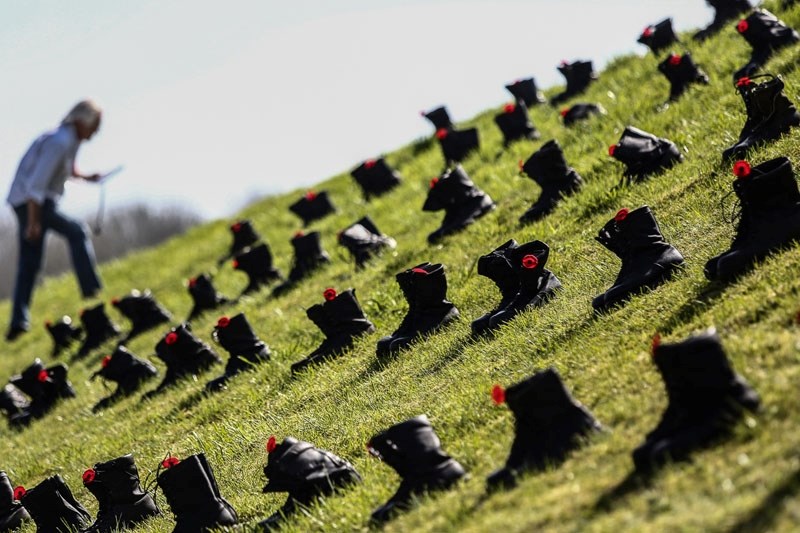It's the boots that he will remember most, said Simon Pagé.
It's April 9, 2017. Pagé, a teacher at Sir George Simpson, is at the Canadian National Vimy Memorial in France as part of the official Canadian delegation for the hundred-year anniversary of the Battle of Vimy Ridge.
A century ago, this place was a maelstrom of wet snow and exploding shells as nearly 100,000 Canadian troops surged from the trenches to attack German forces on the ridge, running headlong through machine gun fire and a sea of mud and corpses.
Today, the land is a verdant moonscape of grassy craters. The sun is high and scorching, and the Vimy memorial stands tall.
Around and on it are some 3,598 pairs of used black boots, many of which have red poppies on them – one pair for each Canadian soldier who died at Vimy, Pagé said. Canadian students under his supervision spent about three hours placing about 800 of them in four straight lines – one for each division in the battle – leading up to the monument. Prince William and Prince Harry of Britain placed the final pairs on the monument itself.
"The kids really understood their role," Pagé said of the students, and treated it with great respect.
"They had the lives of a soldier in their hands."
Duties of delegates
Some 25,000 people attended the April 9 ceremony at the Vimy memorial, including Prime Minister Justin Trudeau and François Hollande, the president of France.
Some 10,000 of the attendees were students, 34 of whom were from Sturgeon Composite.
Grade 11 student Amanda Porter said it was her first visit to the memorial.
"I'm really interested in Canadian history. I find it quite fascinating how much the Battle of Vimy Ridge developed Canada as a nation."
Sturgeon Composite teacher Mike Johnson was there as a bagpipe player with the RCMP Regimental Pipes and Drums. He and his group played at the monument in the days before and after the ceremony and marched during it.
Pagé was one of the two teacher chaperones for the 26 high school and university students picked from across Canada to represent the nation's youth in the April 9 ceremony.
Pagé said he and his delegation travelled with Canadian veterans to many cemeteries and sites around Vimy, France, to learn more about First World War history. The students had to research and report on a First World War Canadian soldier while there. Some of them recited the official pledge of remembrance for a film crew that aired their remarks during the April 9 event.
The students were excellent public speakers and great ambassadors for their nation, Pagé said. The veterans found them very easy to chat with, and many "adopted" kids from their home provinces.
Pagé was also busy, placing 30-odd small wooden crosses decorated by Simpson students at various war graves. He also delivered a flag from the people of Vimy, Alberta to a delegate from Vimy, France.
The big day
Johnson said he first got to the Vimy site near sunrise on April 5.
"You can see why it (the ridge) was a strongpoint for the Germans," he said, as it has great sight-lines and is visible from miles away.
Every home they passed on the drive up was festooned with Canadian flags and had residents outside cheering them on, he said.
"That was really kind of touching."
Seeing the monument take up your entire field of view was a surreal experience, said Sturgeon Composite student Spencer Theroux.
"It goes to show how important people think it is and how important it really was."
Theroux said he and his classmates got to explore some of the trenches that had been restored around the monument. Despite being widened for tourists, they were still very cramped.
"You can understand how claustrophobic it would have been for those people tunnelling down there."
The tunnels would have been constantly wet, too, as the porous soil let the rain right through. Theroux said he couldn't imagine living in that darkness.
"It's absolutely insane."
Whereas the memorial site was grey, windy and cold on April 5, it was bright, still and a scorching 25 C on April 9, Johnson said – and he was in nine yards of wool kilt.
"It was ridiculously hot," he said, and the medical tents were full of people with heatstroke.
It was often hard to move around on April 9 between the thousands of people and the security measures, Johnson said.
The ceremony featured speeches, interpretive dancers, First Nations singing and drumming, a fly-past of five First World War fighter planes and dramatizations of the lives of soldiers at Vimy. Porter said the latter helped personalize the battle, which we often talk of in terms of statistics.
Announcers also recited the names of the 3,598 Canadians who died at Vimy – a list that never seemed to end, Theroux said.
"You get a real (sense of the) scale of how many people died there."
Theroux and Porter said they hoped to continue to honour those who fell at Vimy and to carry on their lessons of the importance of peace and co-operation.
Pagé said he had faith that the memory of Vimy Ridge would live on. The students he worked with all took pledges to get involved with Remembrance Day activities, talk with veterans and pass on their experiences at Vimy. He himself planned to speak to Simpson and Paul Kane students about his trip soon.
"It's now up to the youth to carry the torch."




